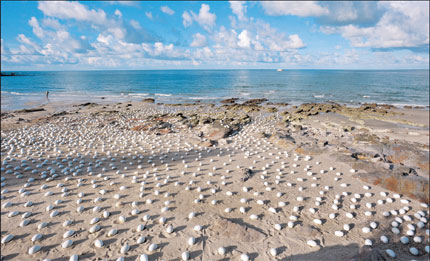 |
|
At the first stop of Shi Shaoping's installation project "Metamorphosis: Egg," 3,000 eggs are laid on the beach of Beihai, a protected area for migratory birds in Guangxi Zhuang Autonomous Region.(Photo/Shanghai Daily)
|
Artist Shi Shaoping did what everyone said was impossible: He fired 3,000 2kg ceramic eggs and now he's arranging all of them in some of China's most desolate locations to create provocative installation art. Wang Jie makes an omelet.
Artist and ceramist Shi Shaoping is "laying" 3,000 white ceramic eggs in six remote settings for art installations in China.
In each of the six locations, all in the scorching sun, Shi and his team deposit all 3,000 eggs, carefully arranged to provoke reflection. The whole process and final installation is photographed and videotaped for a final exhibition in Beijing in August - 3,000 eggs and video.
The eggs remain for three or four days and then they're loaded up into two, 30-ton trucks and driven to the next destination. All but one of the sites are in harsh and arid Gansu Province on the Silk Road.
Some arrangements in desolate terrain look like scenes on another planet. Or perhaps they're dinosaur eggs, or extra-terrestrial eggs.
Right now the eggs are heading to the sand dunes of Dunhuang in Gansu.
"The interesting part of this work is that if these 3,000 eggs are put against a different backdrop, they will have different meanings for the viewers," Shi told Shanghai Daily in an interview on the harsh Beihai coast, a sanctuary for migratory birds in southern China's Guangxi Zhuang Autonomous Region.
"I deliberately selected some geographic environments with unique characteristics that might evoke some reflections on life and nature from the viewers."
The egg-meets-landscape project is titled "Metamorphosis: Eggs." They follow the dramatic arrangement of all 3,000 eggs at the plaza in front of the Shanghai Contemporary Art Fair last summer.
"Einstein once said that if an idea doesn't sound absurd at the very beginning, then don't put much hope in it," Shi says of what many people called his mission impossible in both ceramic art and art installation.
"I am not a person who easily abandons what I believe," says the artist who has lost at least 15kg since the project started in mid-July. "Some people said I am insane, but I know what I am doing."
The first site in mid-July was the rugged Beihai coast. The next sites were and are all in Gansu. In chronological order, they are the yardang region of strange, wind-carved rock formations; the Gobi Desert; the sand dunes of Dunhuang with its Buddhist grottoes; and the Gannan grasslands.
The final stop will be Beijing in August for a big show at Today Art Museum in Beijing, from August 25 to September 11.
"The eggs symbolize nurturing life, but since they are solid, there is no room for new life, thus, the installations reflect the collision of hopes and desperation."
Like dinosaur eggs, his work can last for 10,000 years, says Shi, who is in his mid-40s.
The project is a dramatic departure from Shi's mysterious, watery "metamorphosis" paintings of frogs and strange aquatic creatures, some made with real frog skin. His studio is a former Russian Orthodox Church in Shanghai's former French Concession, where he used to work in seclusion on his "creature paintings."
A native of Jiangxi Province, Shi majored in stage design at the Shanghai Theater Academy, which has nurtured big names in contemporary art, including Chen Zhen, Li Shan and Cao Guoqiang.
Unlike many artists who promote their new work and new directions with frequent exhibits, Shi works quietly and then veers off into a different direction, this time ceramic art that challenges traditional perceptions of ceramics.
Making enormous solid forms, such as his eggs, is extremely difficult and has seldom been attempted, Shi says.
"But when I was told by the ceramist in the ceramics capital Jingdezen, Jiangxi Province that it was impossible to fire these solid eggs due to the bubbles, I didn't give up." When the clay is heated in a kiln, the air expands and the object can explode.
We recommend:
